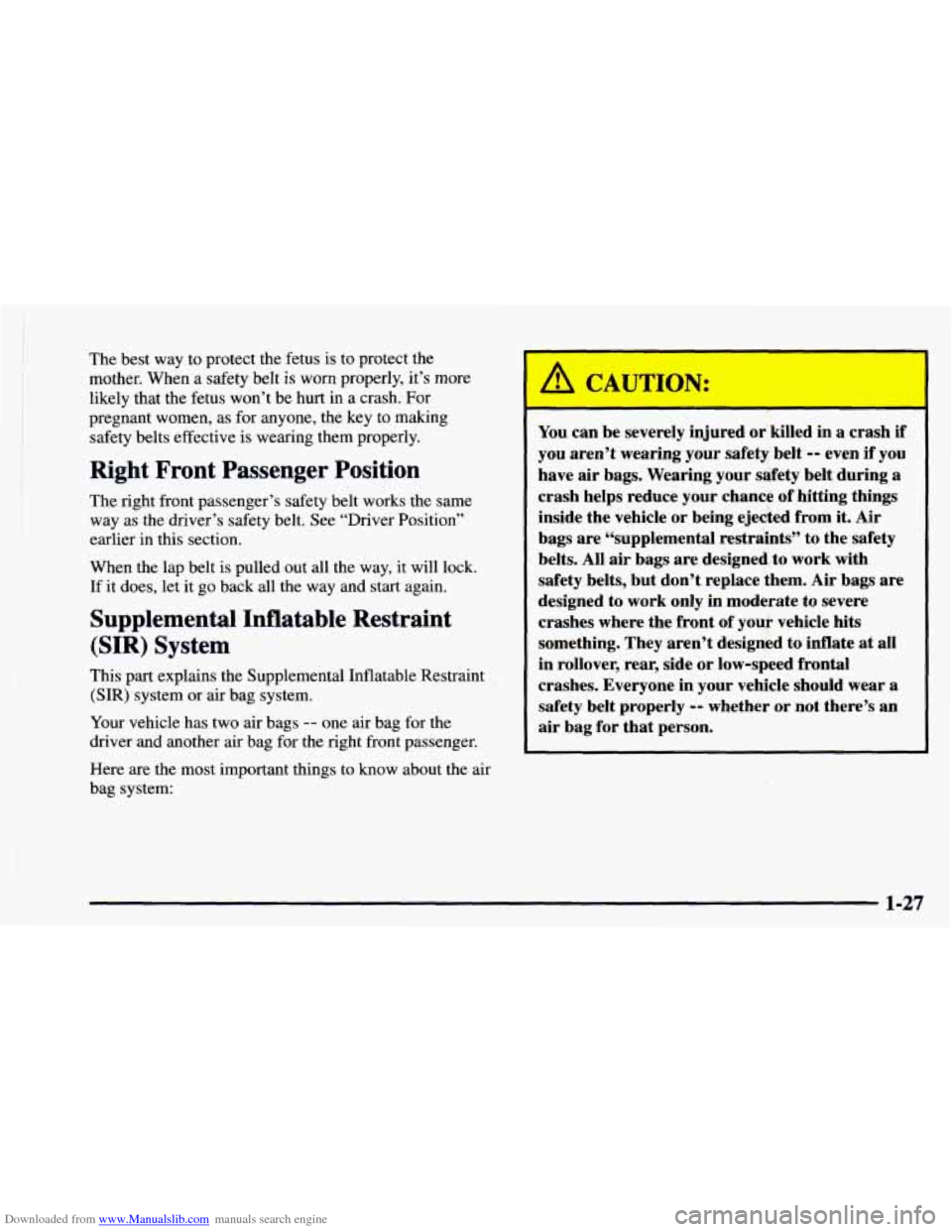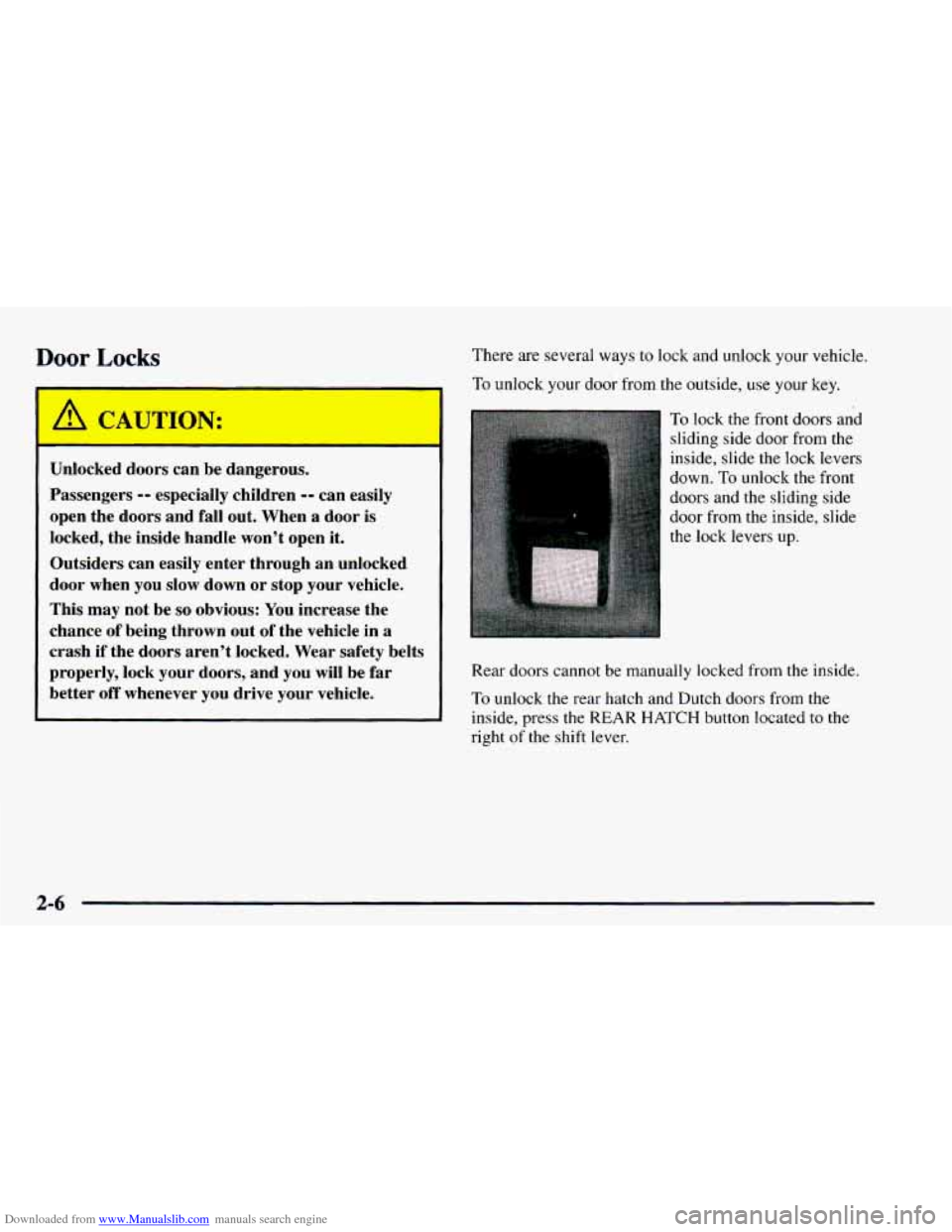Page 27 of 404
Downloaded from www.Manualslib.com manuals search engine The lap part of the belt should be worn low and snug on
the hips, just touching the thighs. In a crash, this applies
force to the strong pelvic bones. And you’d
be less likely
to slide under the lap belt. If you slid under
it, the belt
would apply force at your abdomen.
This could cause
serious or even fatal injuries. The shoulder belt should go
over the shoulder and across the chest. These parts
of the
body are best able to take belt restraining forces.
The safety belt locks
if there’s a sudden stop or a crash.
1-19
Page 28 of 404
Downloaded from www.Manualslib.com manuals search engine Shoulder Belt Height Adjuster
Before you begin to drive, move the shoulder belt
adjuster to the height that is right for you.
To move it down, push in at the top of the arrows and
move the height adjuster to the desired position. You can
move the adjuster up just by pushing up on the shoulder
belt guide. After you move the adjuster
to where you
want it, try to move it down without pushing in to make
sure it has locked into position.
Adjust
the height so that the shoulder portion of the belt is
centered
on your shoulder. The belt should be away from
your face and neck, but not falling
off your shoulder.
1-20
Page 35 of 404

Downloaded from www.Manualslib.com manuals search engine The best way to protect the fetus is to protect the
mother. When a safety belt is worn properly, it’s more
likely that the fetus won’t be hurt in a crash. For
pregnant women, as for anyone, the key to malung
safety belts effective is wearing them properly.
Right Front Passenger Position
The right front passenger’s safety belt works the same
way as the driver’s safety belt. See “Driver Position”
earlier in this section.
When the lap belt is ,pulled out all the way,
it will lock.
If it does, let it go back all the way and start again.
Supplemental Inflatable Restraint
(SIR) System
This part explains the Supplemental Inflatable Restraint
(SIR) system or air bag system.
Your vehicle has two air bags
-- one air bag for the
driver and another air bag for the right front passenger.
Here are the most important things to know about the air
bag system:
You can be severely injured or’killed in a crash if
you aren’t wearing your safety..belt
-- even if you
have air bags. Wearing your safety belt during a
crash helps reduce your chance of hitting things
inside the vehicle or being ejec‘ted from it. Air
bags are “supplemental restraints” to the safety
belts.
All air bags are designetkto work with
safety belts, but don’t replace them. Air bags are
designed
to work only in moderate to severe
crashes where the front of your vehicle hits
something. They aren’t designed to inflate at all
in rollover, rear, side or low-speed frontal
crashes. Everyone in your vehicle should wear a
safety belt properly
-- whether or not there’s an
air bag for that person.
----- 1-27
Page 44 of 404
Downloaded from www.Manualslib.com manuals search engine The lap part of the belt should be worn low and snug on
the hips, just touching the thighs. In a crash, this applies
force to the strong pelvic bones. And you'd
be less likely
to slide under the lap belt. If you slid under it, the belt
would apply force at your abdomen. This could cause
serious or even fatal injuries. The shoulder
belt should go
over the shoulder and across the chest. These parts of the
body are best able to take belt restraining forces.
The safety belt locks
if there's a sudden stop or a crash.
You can be seriously hurt if your shoulder belt is
too loose. In a crash, you would move forward
too much, which could increase injury. The
shoulder belt should fit against your body.
To unlatch the belt, just push the button on the buckle.
1-36
Page 69 of 404
Downloaded from www.Manualslib.com manuals search engine 6. Pull the rest of the lap belt all the way out of the
retractor to set the lock. 7. To tighten the belt, feed the lap belt back into the
8. Push and pull the child restraint in different
To remove the child restraint, just unbuckle the vehicle’s
safety belt and let it go back all the way. The safety belt
will move freely again and be ready to work for an adult
or larger child passenger. retractor
while you push down
on the child restraint.
directions to be sure it is secure.
1-61
Page 75 of 404

Downloaded from www.Manualslib.com manuals search engine Section 2 Features and Controls
Here you can learn about the many standard and optional features on your vehicle, and information on starting,
shifting and braking. Also explained are the instrument panel and the warning systems that tell you if everything is
working properly
-- and what to do if you have a problem.
2-2
2-4 2-4
2- 6
2-7
2-
10
2- 12
2-
14
2- 15
2-15
2- 17
2-1 8
2- 19
2-22
2-22
2-23
2-24
2-26 Keys
Front
Doors
Rear Doors
Door Locks
Keyless Entry System
Sliding Door
Hatch
Theft New Vehicle “Break-In”
Ignition Positions
Starting Your Engine
Engine Coolant Heater (Option)
Automatic Transmission Operation
Locking Rear Axle All-Wheel Drive (Option)
Parking Brake
Shifting Into PARK (P)
Shifting Out
of PARK (P) 2-27
2-27
2-28
2-29
2-3
1
2-3 1
2-3 1
2-37
2-39
2-4
1
2-42
2-50
2-5
1
2-52
2-5
3
2-56
2-58
2-60 Parking
Over Things That Burn
Engine Exhaust
Running Your Engine While You’re Parked
Windows
Horn
Tilt Wheel (If Equipped)
Turn Signal/Multifunction Lever
Lamps Interior Lamps
Mirrors Storage Compartments
Ashtrays and Cigarette Lighter
Sun Visors
Accessory Power Outlets (Option)
Universal Transmitter (Option)
Instrument Panel
Instrument Panel Cluster
Warning Lights, Gages and Indicators
2-1
Page 77 of 404
Downloaded from www.Manualslib.com manuals search engine This vehicle has one
double-sided key for the
ignition and door locks. It
will fit with either side
up.
The bar-coded tag has a code on it that tells your dealer
or a qualified locksmith how to make extra keys. Keep
this tag
in a safe place. If you lose your keys, you’ll be
able to have new ones made easily using this tag.
When
a new vehicle is delivered, the dealer provides the
owner with a pair
of identical keys and a bar-coded tag.
I NOTICE:
Your vehicle has a number of new features that
can help prevent theft. But you can have a lot
of trouble getting into your vehicle if you ever lock your keys inside. You may even have to
damage your vehicle to get in.
So be sure you
have extra keys.
2-3
Page 80 of 404

Downloaded from www.Manualslib.com manuals search engine Door Locks
Unlocked doors can be dangerous.
Passengers
-- especially children -- can easily
open the doors and fall out. When
a door is
locked, the inside handle won’t open it.
Outsiders can easily enter through an unlocked
door when you slow down or stop your vehicle.
This may not be
so obvious: You increase the
chance of being thrown out
of the vehicle in a
crash if the doors aren’t locked. Wear safety belts
properly, lock your doors, and you will be far
better
off whenever you drive your vehicle.
There are several ways to lock and unlock your vehicle.
To unlock your door from the outside, use your key.
To lock the front doors and
sliding side door from the
inside, slide the lock levers
down.
To unlock the front
doors and
the sliding side
door from the inside, slide
the lock levers up.
Rear doors cannot be manually locked from the inside.
To unlock the rear hatch and Dutch doors from the
inside, press the
REAR HATCH button located to the
right of the shift lever.
2-6